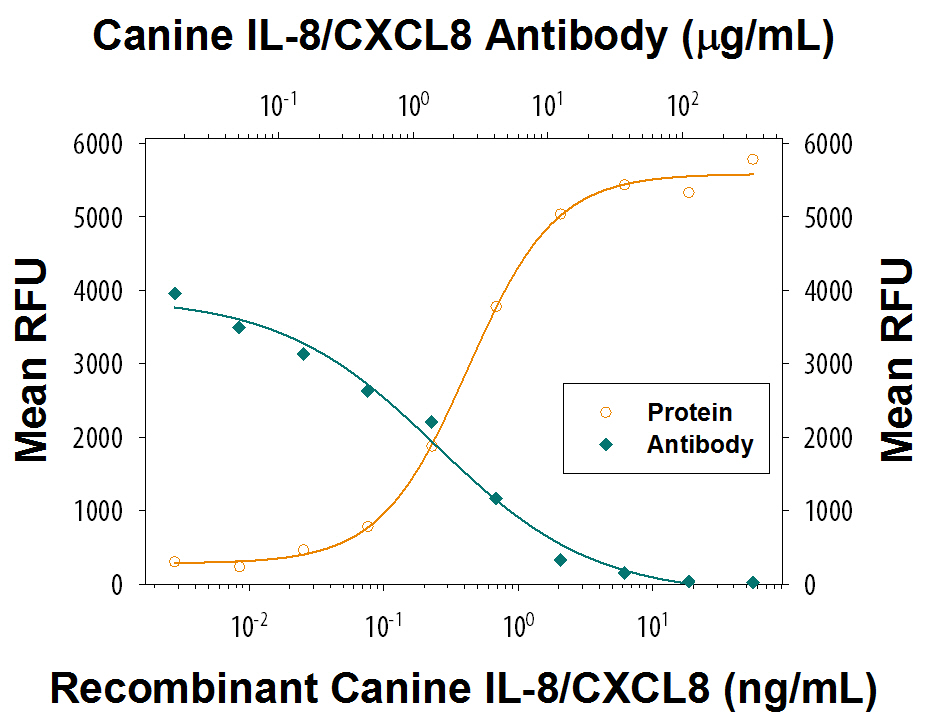Canine IL-8/CXCL8 Antibody Summary
Ala23-Pro101
Accession # P41324
Applications
Canine IL-8/CXCL8 Sandwich Immunoassay
Please Note: Optimal dilutions should be determined by each laboratory for each application. General Protocols are available in the Technical Information section on our website.
Scientific Data
 View Larger
View Larger
Chemotaxis Induced by CXCL8/IL‑8 and Neutralization by Canine CXCL8/IL‑8 Antibody. Recombinant Canine CXCL8/IL-8 (Catalog # 1608-CL) chemoattracts the BaF3 mouse pro-B cell line transfected with human CXCR2 in a dose-dependent manner (orange line). The amount of cells that migrated through to the lower chemotaxis chamber was measured by Resazurin (Catalog # AR002). Chemotaxis elicited by Recombinant Canine CXCL8/IL-8 (10 ng/mL) is neutralized (green line) by increasing concentrations of Canine CXCL8/IL-8 Monoclonal Antibody (Catalog # MAB16081). The ND50 is typically 3-12 µg/mL.
Reconstitution Calculator
Preparation and Storage
- 12 months from date of receipt, -20 to -70 °C as supplied.
- 1 month, 2 to 8 °C under sterile conditions after reconstitution.
- 6 months, -20 to -70 °C under sterile conditions after reconstitution.
Background: IL-8/CXCL8
Interleukin 8 (IL-8), also named monocyte-derived neutrophil chemotactic factor (MDNCF), neutrophil-activating protein 1 (NAP-1), neutrophil-activating factor (NAF) and granulocyte chemotactic peptide (GCP), belongs to the Glu-Leu-Arg motif containing (ELR+) CXC chemokine family and has been designated CXCL8. IL-8 is a potent neutrophil chemoattractant that recruits neutrophils to sites of inflammation. IL-8 also activates neutrophil functions and through a poorly understood mechanism, promotes angiogenesis. The biological activites of IL-8 is mediated by two types of G protein-coupled chemokine receptors, CXCR1 and CXCR2. In normal tissues, IL-8 expression and secretion is barely detectable. Upon stimulation by a wide range of pro-inflammatory signals including exposure to IL-1, TNF, bacterial or viral products, IL-8 production is rapidly induced in many different cell types. Secreted IL-8 is not glycosylated but has N-terminal sequence heterogenecity due to proteolytic processing. In human, two major forms, the 72 amino acid (aa) monocyte-derived IL-8 and the 77 aa endothelial IL-8 have been identified. Whereas the 72 aa isoform is a more potent chemoattractant, only the 77 aa isoform can induce apoptosis in leukemic cells. The N-terminal pentapeptide in the 77 aa isoform has been identified as the active site for the IL-8 apoptotic activity. Canine IL-8 encodes a 101 aa precursor protein with a putative 22 aa signal peptide. It shares 77% and 87% aa sequence identity with human and porcine IL-8, respectively. Similar to human IL-8, recombinant canine IL-8 also undergoes
N‑terminal processing. Two major peptides (the 79 aa and 74 aa variants that differ by an analogous N-terminal pentapeptide) are present in the recombinant canine IL-8 preparations.
- Van Damme, J. et al. (1998) in The Cytokine Handbook, A.W. Thomson, ed., Academic Press, New York., p. 271.
- Terui, Y. et al. (1998) Blood, 92:2672.
- Terui, Y. et al. (1999) Cancer Research 59:5651.
Product Datasheets
FAQs
No product specific FAQs exist for this product, however you may
View all Antibody FAQsReviews for Canine IL-8/CXCL8 Antibody
There are currently no reviews for this product. Be the first to review Canine IL-8/CXCL8 Antibody and earn rewards!
Have you used Canine IL-8/CXCL8 Antibody?
Submit a review and receive an Amazon gift card.
$25/€18/£15/$25CAN/¥75 Yuan/¥2500 Yen for a review with an image
$10/€7/£6/$10 CAD/¥70 Yuan/¥1110 Yen for a review without an image




